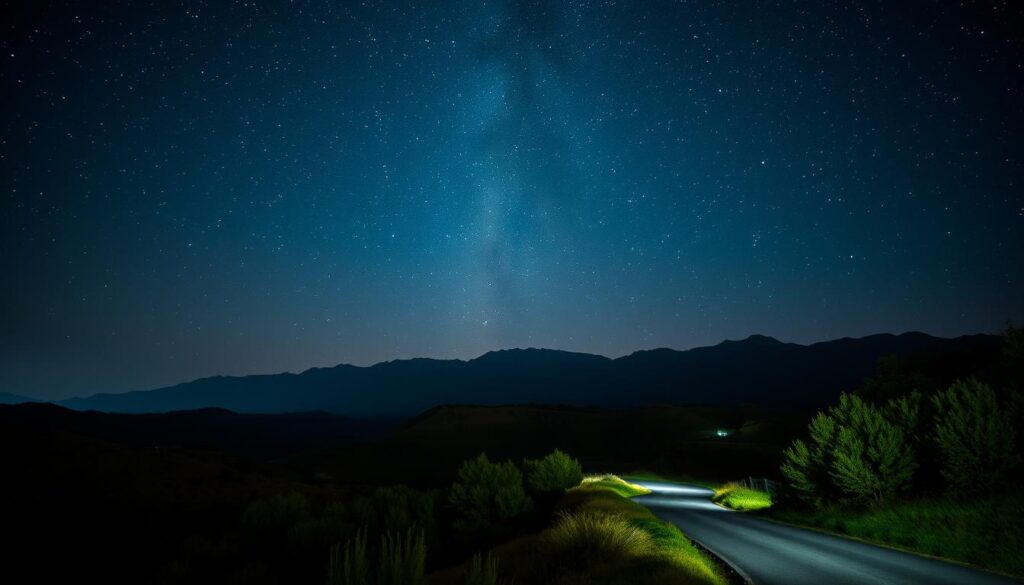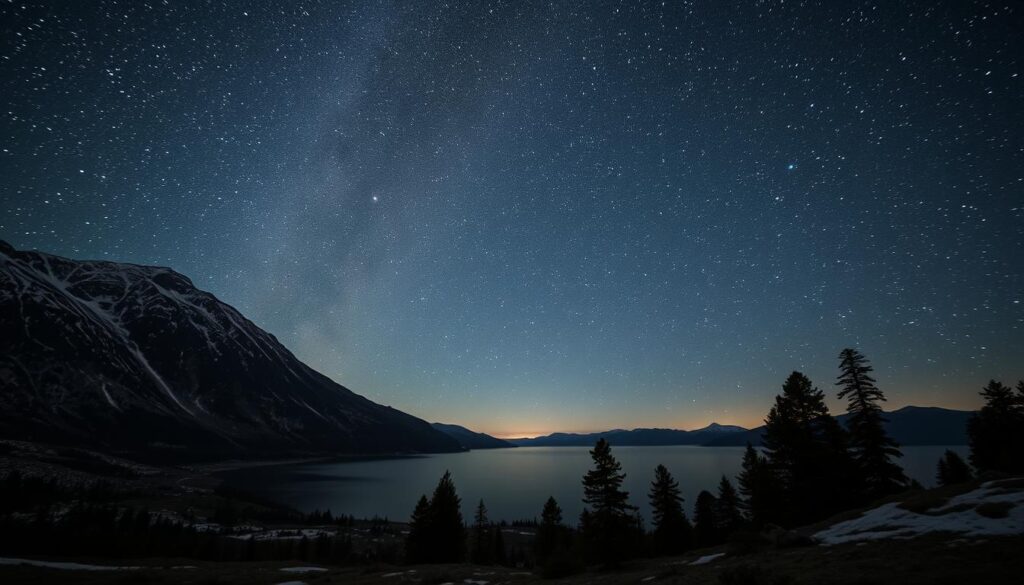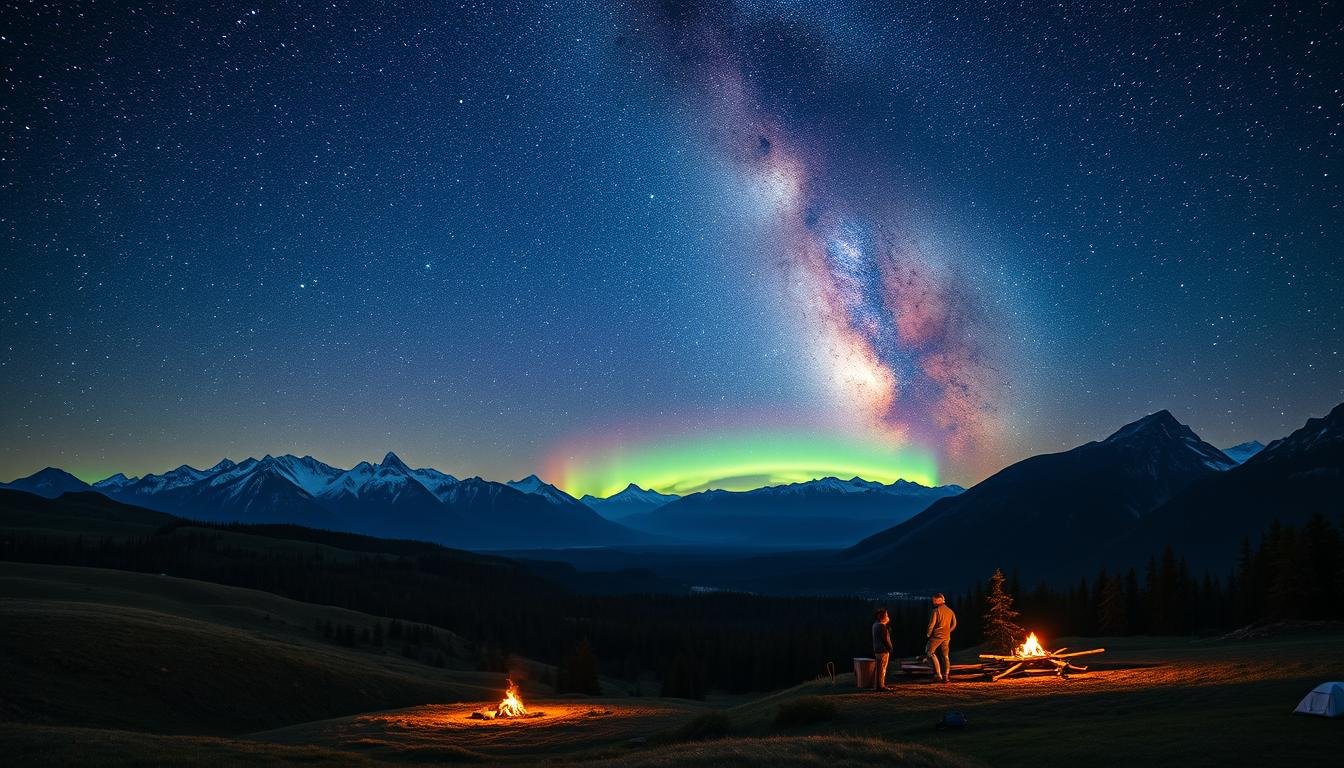Have you ever stood beneath a sky so clear it feels like the stars could spill into your hands? I remember my first time—knees pressed into cool grass, breath hanging in the air, and a universe of light stretching endlessly above. It wasn’t just a moment. It was a reminder of how small we are, and how vast the world becomes when daylight fades.
This year, more adventurers than ever are trading crowded cities for quiet nights under open skies. With over 80% of Americans affected by light pollution, finding true darkness has become a rare treasure. That’s where certified Dark Sky locations shine—literally. From coast to coast, these protected areas offer front-row seats to meteor showers, constellations, and the Milky Way’s glow.
Planning your journey? Resources like Travelyoudo.com make it easy to explore these celestial wonders. Whether you’re chasing the Northern Lights or simply craving stillness, 2025 brings new opportunities to connect with nature’s nightly spectacle. Rangers now host moonlit hikes and telescope workshops, blending education with awe.
Key Takeaways
- Over 80% of Dark Sky Parks worldwide are located in the United States
- Guided night programs combine education with unforgettable celestial views
- Light pollution-free zones reveal hidden details of the Milky Way
- 2025 features rare astronomical events perfect for timing your visit
- State and national parks offer varying levels of accessibility and amenities
Introduction to Nighttime Adventures in the Stars
There’s a quiet magic that unfolds when daylight fades and the cosmos takes center stage. More explorers now seek moments where whispers of wind replace city noise, and constellations become their compass. This shift toward after-dark discovery isn’t just trending—it’s reshaping how we experience nature’s hidden wonders.
What Is Noctourism?
Nighttime exploration goes beyond typical vacations. It’s about capturing the Milky Way through a camera lens, tracing animal tracks under moonlight, or simply sitting still as meteors streak overhead. These activities thrive in areas free from artificial lights, where even faint stars shine brightly.
Travelyoudo.com reports a 140% increase in bookings for “dark sky itineraries” since 2023. Visitors often describe these journeys as transformative, blending relaxation with cosmic education. Rangers now teach constellation lore and eclipse mechanics during evening programs.
Why Focus on Celestial Events Next Year?
The coming months offer rare chances to witness astronomical highlights. From meteor showers to eclipses, 2025 delivers a packed schedule of celestial theater. Planning around these dates ensures unforgettable views you can’t replicate on a screen.
| Event | Peak Dates | Visibility |
|---|---|---|
| Lyrid Meteor Shower | April 21-22 | Northern Hemisphere |
| Perseid Meteor Shower | August 12-13 | Worldwide |
| Partial Solar Eclipse | September 21 | Americas, Europe |
| Total Lunar Eclipse | March 3, 2026 | Asia, Australia |
Darkness isn’t just absence of light—it’s a gateway to perspective. As one traveler noted, “You realize how small daily stresses are when faced with the infinite.” Whether chasing shooting stars or savoring silence, these adventures leave lasting imprints.
Noctourism Stargazing Travel USA Parks 2025
Imagine a place where the night sky isn’t just a backdrop but the main attraction. Across America, certified dark sky locations work tirelessly to preserve this vanishing resource. Travelyoudo.com’s top-rated destinations reveal how these spaces combine conservation with cosmic wonder.

Featured Dark Sky Certifications
The International Dark-Sky Association awards certifications to areas meeting strict light-control standards. To earn this title, locations must implement shielded outdoor lighting, community education programs, and annual sky-quality measurements. Over 70% of the world’s certified international dark sky parks lie within U.S. borders—a testament to America’s conservation leadership.
Certification tiers range from Gold (pristine skies) to Bronze (improving conditions). Gold-tier parks like Cosmic Campground, NM, offer views of 15,000+ stars. Rangers often joke, “Our light pollution comes from the Milky Way itself.”
Unparalleled Nighttime Experiences
These protected zones host astronomy workshops and meteor shower viewing parties. Special red-light flashlights preserve night vision, while heated observation decks make winter visits comfortable. One visitor shared, “I finally understood why ancient cultures mapped the stars—it’s humbling and thrilling.”
Beyond celestial shows, dark sky preservation supports wildlife migration and cuts energy waste. Communities near these destinations report increased tourism revenue without sacrificing their starry skies. It’s a win for both galaxies and Main Street.
Exploring America’s Iconic National Parks After Dark
When sunlight fades, some landscapes don’t sleep—they transform. Hoodoos cast long shadows under moonlight, while desert valleys hum with nocturnal life. These after-hours wonders turn familiar trails into celestial theaters.
Bryce Canyon and Big Bend National Parks
Bryce Canyon National Park redefines night exploration. Its crimson spires glow silver under starlight, creating an alien landscape. Travelyoudo.com experts recommend joining the free ranger-led tours during the Annual Astronomy Festival. “You’ll learn to read constellations like roadmaps,” says one guide.
April through October offers crisp skies here. Milky Way views stretch from horizon to horizon. Bring layers—night temps drop fast at 8,000 feet elevation.
Stars, Silence, and Scenic Wonders
Down in Texas, Big Bend National Park serves silence with its stars. Its International Dark Sky Park status means zero light pollution. You’ll spot shooting stars without telescopes—just lean back and watch.
Desert critters like kangaroo rats emerge after dark. Rangers suggest red-filtered flashlights to preserve night vision. Planning a trip? The drive from San Antonio takes six hours, but the payoff—hearing your own heartbeat under infinite skies—is worth it.
Both parks prove darkness isn’t empty. It’s full of whispers, wonders, and connections waiting overhead.
Discovering Hidden Gems for Stargazing in the USA
Some of nature’s greatest shows don’t require tickets—just patience and the right location. Beyond famous landmarks, smaller sanctuaries preserve darkness like precious heirlooms. These spots offer front-row seats to celestial dances few ever witness.

Cherry Springs State Park Highlights
Nestled in Pennsylvania’s mountains, Cherry Springs holds Gold Tier dark sky status—a rare honor. White lights vanish after sunset here, letting eyes adjust to natural darkness. One regular visitor notes, “The Milky Way looks close enough to taste.”
Travelyoudo.com suggests joining free star parties where astronomers share telescopes. Essential gear includes:
- Red-filtered flashlights (white light prohibited)
- Reclining chairs for hours of sky scanning
- Star chart apps like SkyView®
Anza-Borrego Desert State Park Tips
California’s desert jewel shines brightest from March-May and October-November. Crisp nights reveal galaxies while daytime blooms paint the sands. Photographers flock here for night sky images framed by jagged rock formations.
| Feature | Cherry Springs | Anza-Borrego |
|---|---|---|
| Best Season | June-September | Spring/Fall |
| Unique Activity | Public telescope sharing | Moonlit canyon hikes |
| Temperature Tip | Pack winter gear | Layer for 40°F swings |
Rangers recommend arriving before twilight to watch stars emerge like diamonds on velvet. As one Travelyoudo.com reviewer shared, “Sunset here isn’t an ending—it’s the main event’s curtain rise.”
Historic & Cultural Destinations Under the Night Sky
Ancient stones whisper secrets of the cosmos at these heritage sites. Across the Southwest, preserved ruins reveal how past civilizations tracked celestial patterns with astonishing precision. Travelyoudo.com’s cultural experts guide visitors through landscapes where history and astronomy collide.
Chaco Culture National Historical Park Insights
At Chaco Canyon, 1,000-year-old buildings align perfectly with solstice sunrises. Summer night sky festivals here blend stargazing with Ancestral Puebloan history. Rangers demonstrate how ancient astronomers used stone slabs as celestial calendars. “You’re not just seeing stars—you’re decoding messages from the past,” notes a Travelyoudo.com guide.
Mesa Verde National Park: Ancient Skies
Cliff dwellings aren’t Mesa Verde’s only marvel. The Ancestral Puebloans positioned structures to mirror constellations like Orion’s Belt. Summer programs let visitors observe these alignments through telescopes while learning indigenous star lore. One participant shared, “The silence here makes the sky feel alive with stories.”
| Feature | Chaco Culture | Mesa Verde |
|---|---|---|
| Best Visiting Season | Fall | Summer |
| Celestial Highlight | Winter Solstice Alignment | Orion Structure Matches |
| Unique Offering | Astro-Archaeology Tours | Nighttime Cliff Dwelling Talks |
Both destinations offer more than dark skies—they’re outdoor classrooms. As moonlight bathes ancient walls, modern travelers gain new appreciation for humanity’s eternal dance with the stars.
Urban Escapes and City-Based Dark Sky Experiences
Cities often dazzle with neon, but some urban gems reveal celestial wonders after sunset. Thoughtful light policies create oases where constellations pierce through the glow. These destinations prove vibrant city life and starry skies can coexist.
Where Urban Meets Cosmic
Flagstaff shines as the world’s first International Dark Sky City. Its streetlights use shielded amber bulbs to protect visibility. Visitors join nightly telescope sessions at Lowell Observatory. “You’ll see Saturn’s rings through century-old lenses,” says a Travelyoudo.com local guide.
Red Rock Mysteries After Dark
Sedona’s famed rock formations gain new magic under night skies. Certified tours combine astronomy with vortex energy walks. Red-filtered flashlights preserve darkness while revealing hidden trails. One traveler noted, “The stars here feel like part of the landscape.”
Both cities showcase how urban areas can champion dark sky preservation. From educational programs to mindful lights regulations, they make cosmic experiences accessible without leaving city limits.
FAQ
What makes 2025 a special year for stargazing in the USA?
2025 offers unique celestial events like meteor showers and solar eclipses, plus expanded Dark Sky Park certifications. Reduced light pollution efforts in places like Bryce Canyon and Big Bend National Park will enhance visibility, making it an ideal time to explore the stars.
How do I find parks with official Dark Sky certifications?
Visit the International Dark-Sky Association website for a full list. Parks like Cherry Springs State Park and Anza-Borrego Desert State Park are certified, offering guided tours, telescopes, and astronomy programs to maximize your experience.
Can I see the northern lights in any U.S. parks?
Yes! Acadia National Park in Maine and Denali National Park in Alaska occasionally offer northern lights displays, especially during solar maximum periods. Check local forecasts and plan visits during colder months for the best chance.
Are there family-friendly stargazing spots with minimal hiking?
Absolutely. Great Basin National Park in Nevada and Joshua Tree National Park in California have accessible viewing areas. Many parks host ranger-led nighttime programs perfect for families, with no strenuous trails required.
What gear do I need for a summer stargazing trip?
Bring a red-light flashlight to preserve night vision, a sturdy telescope or binoculars, and layered clothing for cooler nights. Apps like Star Walk 2 can help identify constellations. Don’t forget a blanket or reclining chair for comfort!
How do urban areas like Flagstaff maintain dark skies?
Flagstaff, the world’s first International Dark Sky City, uses shielded streetlights and strict lighting ordinances. Neighboring spots like Lowell Observatory offer public star parties, blending city convenience with pristine skies.
Can I combine history tours with nighttime sky viewing?
Definitely. Chaco Culture National Historical Park and Mesa Verde National Park blend ancient Puebloan ruins with astronomy programs. Learn how ancestral communities used the stars for navigation and cultural rituals.
Are guided nighttime tours worth booking in places like Sedona?
Yes! Guides in Sedona share insights on Navajo star legends and point out deep-sky objects. Tours often include high-quality telescopes and避开 crowded areas, ensuring a personalized, educational adventure under the stars.




